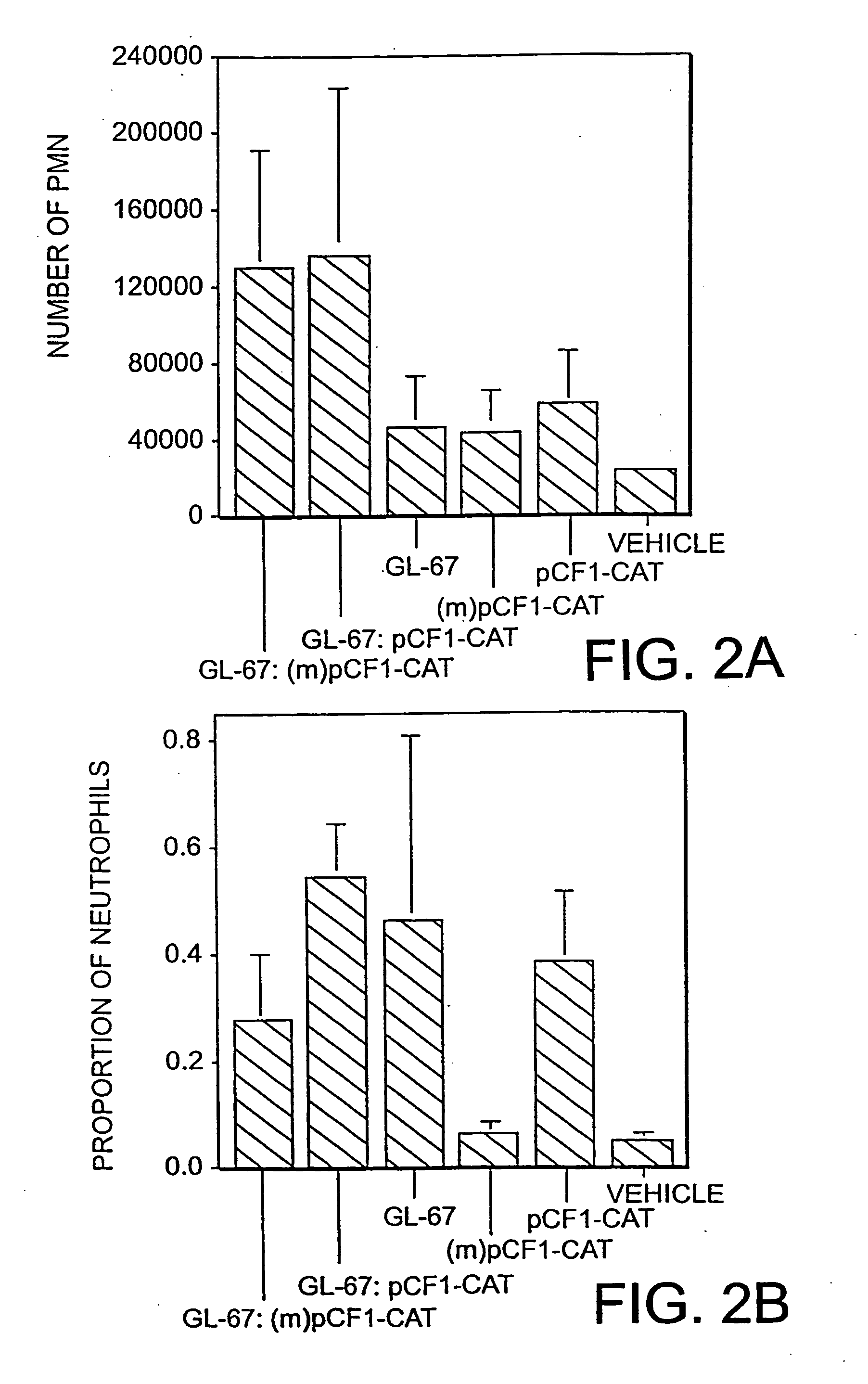Use of cationic lipids to generate anti-tumor immunity
a technology of cationic lipids and lipids, which is applied in the direction of gene therapy, whole-cell/virus/dna/rna ingredients, non-active ingredients, etc., can solve the problems of increased safety risk, increased inflammation or reduction of lung function, and detrimental presence of cpg motifs, etc., to stimulate the anti-tumor cell response
- Summary
- Abstract
- Description
- Claims
- Application Information
AI Technical Summary
Benefits of technology
Problems solved by technology
Method used
Image
Examples
example 1
Construction and Purification of Plasmid DNA
[0065] The construction and characterization of the plasmid vector pCF1-CAT encoding the reporter gene product chloramphenicol acetyltransferase (CAT) has been described previously. See Yew et al. Hum. Gene Ther. 8: 575-584 (1997). pCF1-CAT contains the strong promoter from the human cytomegalovirus immediate-early gene (CMV), an intron, the bovine growth hormone polyadenylation signal sequence, a pUC origin, and the aminoglycoside 3′-phosphotransferase gene that confers resistance to kanamycin. pCF1-null is analogous to pCF1-CAT except that the cDNA for CAT was deleted. pCFA-299-CAT was constructed by digesting pCFA-CAT (identical to pCF1-CAT except for the addition of a small poly linker 5′ of CMV) with Pme I (in the poly linker) and BgI I (in CMV), blunting the ends with the Klenow fragment of DNA polymerase 1, then replicating. This results in deletion of nucleotides −522 to −300 of the CMV promoter.
[0066] Site-directed mutagenesis w...
example 2
In Vitro Methylation of pDNA
[0068] Plasmid DNAs were methylated in vitro in a 5 ml reaction containing 1×NEB buffer 2 [50 mM NaCl, 10 mM Tds-HCI, pH 7.9, 10 mM MgCI2, 1 mM dithiothreitol], 160 μM S-adenosylmethionine (SAM), 1-3 mg of pDNA, and 1 U of Sss I methylase (New England Biolabs) per μg of pDNA. The mixture was incubated at 37° C. for 18 h. Additional SAM was added to a concentration of ISO μM after 4 h of incubation. Mock treatment of pDNA used the same procedure except the Sss I methylase was omitted. Methylated and mock-treated pDNA was centrifuged through a Millipore Probind column, ethanol precipitated, and washed with 70% (v / v) ethanol. The pDNA was resuspended in water to a final concentration of approximately 3 mg / ml. In experiments to examine the effects of Sss I-mediated methylation of pDNA, mock-methylated pDNA was always used as a control.
[0069] The extent of pDNA methylation was assessed by digesting 0.2-0.5 μg of the treated pDNA with 10 U BstU I or Hpa II fo...
example 3
Nasal Instillation of Cationic Lipid:pDNA Complexes into Mice
[0073] The cationic lipid:pDNA complexes were formed by mixing equal volumes of GL67:DOPE (1:2) with pDNA as described previously (Lee et al., Hum. Gene Ther. 7: 1701-1717, (1996)) to a final concentration of 0.6:1.2:3.6 mM (GL-67:DOPE:pDNA) or 0.3:0.6:1.8 mM, as indicated in the figure legends. The DNA concentration is expressed in terms of nucleotides, using an average nucleotide molecular weight of 330 daltons. BALB / c mice were instilled intranasally with 100 μl of complex as described. See Scheule et al., Hum. Gene Ther. 8: 689-707 (1997). The animals were euthanized and their lungs were lavaged 24 h post-instillation using phosphate-buffered saline (PBS). The recovered BALF were centrifuged at 1,500 rpm for 4 min, and the resulting supernatants were removed and frozen at −80° C. for subsequent cytokine analysis. The cell pellets were resuspended in PBS for microscopic determination of cell number and cell types.
PUM
| Property | Measurement | Unit |
|---|---|---|
| Mass | aaaaa | aaaaa |
| Mass | aaaaa | aaaaa |
| Mass | aaaaa | aaaaa |
Abstract
Description
Claims
Application Information
 Login to View More
Login to View More - R&D
- Intellectual Property
- Life Sciences
- Materials
- Tech Scout
- Unparalleled Data Quality
- Higher Quality Content
- 60% Fewer Hallucinations
Browse by: Latest US Patents, China's latest patents, Technical Efficacy Thesaurus, Application Domain, Technology Topic, Popular Technical Reports.
© 2025 PatSnap. All rights reserved.Legal|Privacy policy|Modern Slavery Act Transparency Statement|Sitemap|About US| Contact US: help@patsnap.com



